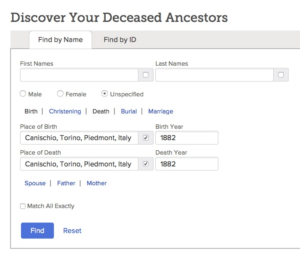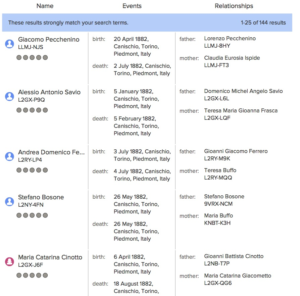In Canischio, there are many people who died as children and whose parents were unknown. They had been abandoned as infants and were living with foster families in Canischio. However, the practices surrounding infant abandonment meant that the children didn’t share a name with either their biological family or their foster family. Further complicating matters, death records do not identify foster families after 1875. This makes placing these children into their foster families a little bit tricky.
Let’s look at the death record for Maria Bongi. Her parents are unknown. She was born in Torino, and died when she was 26 days old on July 30, 1882.
Her death was reported by Pietro Gianone and Gioanni Battista Ferrero. It is possible that the two informants may have some relationship to Maria Bongi, but because deaths in Canischio were not usually reported by close relatives, the informants are not likely to help us very much. More helpful is her address. We can see that she died in a home located at #19 borgata Rua Superiore.
Because Maria is died so young we can assume that whoever was taking care of her had to have a way to nurse her. We are looking for a woman who had recently given birth. Perhaps this mother was willing to nurse a second baby or perhaps her own child had died.
There are a couple ways to approach the search. First you can flip through the images of births in 1881/1882 and see if anyone was born at #19 borgata Rua Superiore. This was my approach in this case. I started in 1882, and very quickly I located the birth record for Giacomo Pecchenino. Checking the death indexes show that Giacomo died a just a few months later on July 2. Most likely, just a few days later, Giacomo’s mother, Claudia Eurosia Ispide, herself abandoned as a child, agreed to care for and nurse Maria Bongi. But, just a few weeks later Maria Bongi also dies.
Another approach is to use the “Find” feature on FamilySearch to quickly narrow down possible foster families. In this case you might search for children who were born and died in Canischio in 1882.

Checking the boxes next to the place eliminates all the surrounding towns and focuses the search on Canischio. Even so, because the dates will be broad, lots of results come up. The closest matches will be at the top. You could quickly look through the people listed and check their addresses in the records looking for #19 borgata Rua Superiore. Conveniently in this case Giacomo happens to be at the top so you would solve your mystery fairly quickly.

This process can help attach connect children to the families that agreed to take them in, care for them, and raise them. Although these children seem isolated in the records, obviously they were part of the community in some way during their lives. But it is important to note that formal adoptions may never have taken place. Also these foster families may have received payment from the town in exchange for caring for abandoned children. This payment may have been suspended after a year or so, but the child would likely have remained with the family through at least early adolescence. As the children grew up, in some cases they were treated more as servants rather than as children of the family.
So while you may know who fostered a child, it may not be fully accurate to assume that the child was adopted or even treated as a member of the family. You would want to look for additional evidence of that type of relationship. As always, when doing genealogical research, a healthy dose of caution and skepticism is prudent to help keep records as accurate as possible.